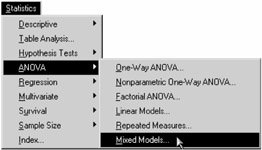Chapter 15: Mixed Models
|
| < Day Day Up > |
|
Introduction
The Mixed Models task provides facilities for fitting a number of basic mixed models. These models enable you to handle both fixed effects and random effects in a linear model for a continuous response. Numerous experimental designs produce data for which mixed models are appropriate, including split-plot experiments, multilocation trials, and hierarchical designs.

Figure 15.1: Mixed Models Menu
A standard linear model is designed to handle fixed effects, in which the levels of the factor represent all possible levels for that factor or at least all levels about which inference is to be made. Factor effects are random effects if the levels of the factor in a study or experiment are randomly selected from a population of possible levels of that factor. The population of possible levels of a random effect has a probability distribution with a mean and a variance. By modeling both fixed and random effects, the mixed model provides you with the flexibility of modeling not only means (as in the standard linear model) but variances and covariances as well.
The mixed model is written
y = Xβ + Zγ + ∊
where y denotes the vector of observed values, X is the known fixed effects design matrix, and β is the unknown fixed effects parameter vector. Zγ represents the additional random component of the mixed model. Here, Z is the known random effects design matrix and γ is a vector of unknown random-effects parameters. Z contains indicator variables constructed from the random effects, just as X contains variables constructed for fixed effects. Finally, ∊ is the unobserved vector of independent and identically distributed Gaussian random errors.
Assume that γ and ∊ are Gaussian random variables that are uncorrelated and have expectations 0 and variances G and R, respectively.

The variance of y is therefore V = ZGZ' + R.
Note that this is a general specification of the mixed model. The Mixed Models task enables you to specify classification random effects that are a special case of the general specification. You can specify that Z contains dummy variables, G contains variance components in a diagonal structure, and R = σ2In, where In denotes the n × n identity matrix.
The Mixed Models task enables you to specify a mixed model that incorporates fixed effects and random classification effects and includes interactions and nested terms. You can select from six estimation methods, including maximum likelihood, restricted maximum likelihood (REML), and MIVQUE. You can also compute least-squares means, produce Type 1, 2, and 3 tests for fixed effects, and output predicted values and means to a SAS data set. Plots include means plots for fixed effects, predicted plots, and residual plots.
The examples in this chapter demonstrate how you can use the Mixed Models task in the Analyst Application to analyze linear models data that contain fixed and random effects.
|
| < Day Day Up > |
|
EAN: 2147483647
Pages: 116